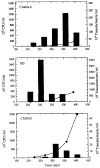Natural transformation of Streptococcus crista
- PMID: 8807795
- PMCID: PMC3534804
- DOI: 10.1111/j.1574-6968.1996.tb08454.x
Natural transformation of Streptococcus crista
Abstract
Over the years Streptococcus gordonii (sanguis) Challis has become the workhorse of genetic manipulations for the sanguis group of oral streptococci. This is because strain Challis was shown in early studies to be highly naturally competent for transformation. However, Challis is not usually the most appropriate strain to use in studies which focus on oral microbial adherence. We report that other members of the newly reorganized sanguis group, particularly within the species S. crista, display reasonable transformation frequencies, with both plasmid and chromosomal DNA, if transformed at the appropriate time during the growth curve. The ability to transform S. crista may be especially important for genetic studies of biological properties that appear to be limited to these specific streptococcal strains.
Figures




Similar articles
-
Genetic exchange between oral streptococci during mixed growth.J Gen Microbiol. 1984 Oct;130(10):2497-500. doi: 10.1099/00221287-130-10-2497. J Gen Microbiol. 1984. PMID: 6512502
-
Prevalence of the amylase-binding protein A gene (abpA) in oral streptococci.J Clin Microbiol. 1999 Dec;37(12):4081-5. doi: 10.1128/JCM.37.12.4081-4085.1999. J Clin Microbiol. 1999. PMID: 10565935 Free PMC article.
-
Genetic transformation in Streptococcus sanguis. Effects on genetic transformation by culture filtrates of Streptococcus sanguis (serogroups H and W) and streptococcus mitis (mitior) with reference to identification.Acta Pathol Microbiol Immunol Scand B. 1985 Aug;93(4):283-7. Acta Pathol Microbiol Immunol Scand B. 1985. PMID: 4050439
-
Genetic competence and transformation in oral streptococci.Crit Rev Oral Biol Med. 2001;12(3):217-43. doi: 10.1177/10454411010120030201. Crit Rev Oral Biol Med. 2001. PMID: 11497374 Review.
-
Molecular genetics of resistance to macrolides, lincosamides and streptogramin B (MLS) in streptococci.J Antimicrob Chemother. 1985 Jul;16 Suppl A:111-35. doi: 10.1093/jac/16.suppl_a.111. J Antimicrob Chemother. 1985. PMID: 3932298 Review.
Cited by
-
Oral microbiota species in acute apical endodontic abscesses.J Oral Microbiol. 2016 Mar 15;8:30989. doi: 10.3402/jom.v8.30989. eCollection 2016. J Oral Microbiol. 2016. PMID: 26983837 Free PMC article.
-
Illuminating the oral microbiome and its host interactions: tools and approaches for molecular microbiology studies.FEMS Microbiol Rev. 2023 Nov 1;47(6):fuac050. doi: 10.1093/femsre/fuac050. FEMS Microbiol Rev. 2023. PMID: 36549660 Free PMC article. Review.
-
The utility of affinity-tags for detection of a streptococcal protein from a variety of streptococcal species.J Microbiol Methods. 2008 Mar;72(3):249-56. doi: 10.1016/j.mimet.2007.12.002. Epub 2007 Dec 15. J Microbiol Methods. 2008. PMID: 18201786 Free PMC article.
References
-
- Gaustad P, Eriksen J, Henriksen SD. Genetic transformation in Streptococcus sanguis. J Oslo City Hosp. 1985;35:83–102. - PubMed
-
- Cole RM, Calandra GB, Huff E, Nugent KM. Attributes of potential utility in differentiating among ‘group H’ streptococci or Streptococcus sanguis. J Dent Res (Special Issue A) 1976;55:A142–A153. - PubMed
-
- Kilian M, Mikkelsen L, Henrichsen J. Taxonomic study of viridans streptococci: description of Streptococcus gordonii sp. novand emended descriptions of Streptococcus sanguis (White and Niven 1964), Streptococcus oralis (Bridge and Sneath 1982), and Streptococcus mitis (Andrewes and Horder 1906) Int J Syst Bacterial. 1989;39:471–484.
Publication types
MeSH terms
Grants and funding
LinkOut - more resources
Full Text Sources

